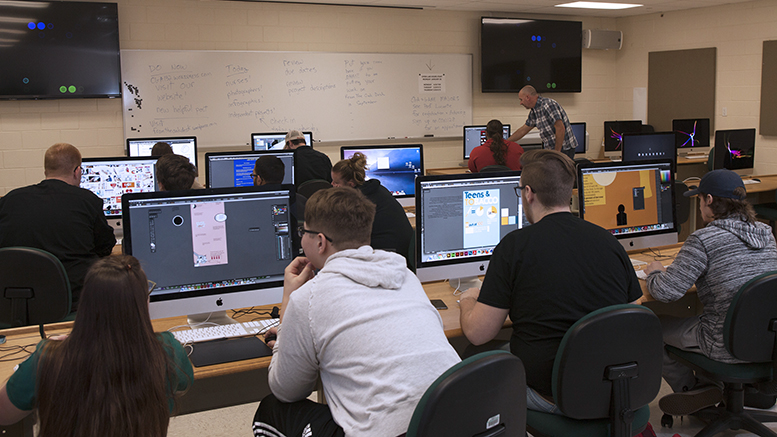When Jason Burden enrolled at Salem Community College (SCC) in southern New Jersey after four years of military service, he had almost zero knowledge of how video games were built.
Now a sophomore in SCC’s video game design and development program, with a double major in graphic communications, Burden is building his own games. In one of his creations, a character jumps across floating platforms. It’s a start that has him excited about working towards a career in the video game or animation field.
According to data from the National Center for Education Statistics (NCES), in 2017, 45 colleges offered associate-degree majors in game and interactive media design. This number is up from 34 in 2013 and 12 in 2010. An additional group of colleges offer associate degrees in fields such as multimedia design, virtual environments, interactive technology and special effects. According to the Higher Education Video Game Alliance, 1,038 higher education institutions offer at least one games-related course, including baccalaureate-granting institutions.
A booming industry
This growth in the number of video game-related majors and courses occurs in the context of a surging gaming industry. According to the Entertainment Software Association (ESA) and market data firm NPD, more than 150 million Americans play video games. These include everything, from battle games such as Fortnite to sports games such as FIFA and educational games. ESA and NPD estimate that U.S. spending on video games climbed 18 percent between 2017 and 2018, reaching $43.4 billion.
Video game-related majors align with a booming job sector. The industry employs more than 220,000 people in the U.S., according to ESA and NPD. The Bureau of Labor Statistics (BLS) foresees expanded job prospects in the sector for everything from programmers to graphic artists to game testers. According to BLS data, the average yearly salary for game designers is $88,510, of whom 57 percent hold bachelor’s degrees.
While a few of the best-known gaming companies are based in California (including Electronic Arts and Activision Blizzard), the industry has a presence across the whole country. For instance, according to gamedevmap.com, a website that maps gaming companies’ locations, 14 studios are in Utah, 91 in Texas, and 84 in Massachusetts.
Power up at SCC
Ken Robell, dean of academic affairs at SCC who spearheaded the creation of the college’s game design and development associate degree program in 2012, says that SCC’s program was designed as a transfer rather than a terminal program. The coursework articulates with a bachelor’s program in game design and development at Wilmington University in nearby New Castle, Delaware.
“Unless someone has a super-human amount of motivation to teach themselves, they should really pursue a bachelor’s degree,” Robell said.
Heeding this advice, Burden intends to transfer to Wilmington University or to another college with a video game-related bachelor’s program after completing his SCC associate degree.
“I’d love to work in a game studio right after graduation, but for me, I expect to get more education,” he said.
The SCC major consists of eight courses drawn from a major in computer graphics, six video game-specific courses specifically created for the major, and a set of general education courses. For subjects such as Game Engines and Game Programming, adjunct instructors were hired, including faculty from Wilmington. Luckily, the college’s pre-existing Mac lab has been able to accommodate the major-specific classes.
The SCC program currently enrolls one cohort each year, which Robell considers a success at the 916-student college. He predicts some enrollment expansion, explaining that “This is a big field. I think that this major is going to continue to grow and provide good solid STEM career opportunities.”
Following the gamebook
SUNY Schenectady County Community College will launch an associate degree in game design programming in this fall that follows the SCC playbook: built for transfer and from existing coursework. The program articulates with a bachelor’s degree in interactive media and game design at SUNY Polytechnic Institute in nearby Utica.
The curriculum completely overlaps with existing courses. Students will be required to take seven computer and information system courses, two management courses, one digital music production course, and general education coursework: there was no need to create any new courses .
The new SUNY Schenectady program will focus on developing students’ programming skills. Its approach is like that of the associate program in game technology at Mesa Community College. At Mesa, students learn the C++, Java, Python and Swift programming languages and become proficient using Adobe and Autodesk software.
Burton Borlongan, a full-time professor in the program, said that this major is “definitely not for students who think that they are only going to play games.”
Yet programs are small
According to NCES data, the average program in game and interactive media design graduated just 8.4 students in 2017. Eight programs graduated between one and five students, and only six programs graduated more than 15. SCC graduated six students in 2017 – a couple students below the mean.
While not necessarily problematic, low enrollments in new majors may bring both high operational costs per student and limited section offerings, which may prolong students’ time-to-degree. Robert Zemsky, a senior scholar at the University of Pennsylvania Graduate School of Education, encourages campuses to be especially thorough in their rationales and enrollment projections before launching new degree programs. He told The Hechinger Report that some major growth is actually “just spreading a thin broth thinner.”
Yet community colleges have a strong impulse to innovate, and the draw of video games is intense. In fact, all those who cannot stop playing Candy Crush and Fortnite can attest to that.

